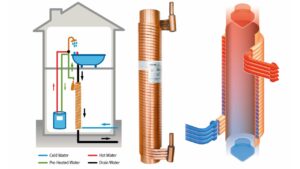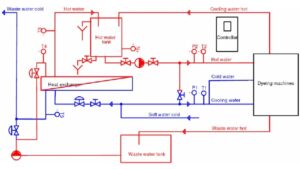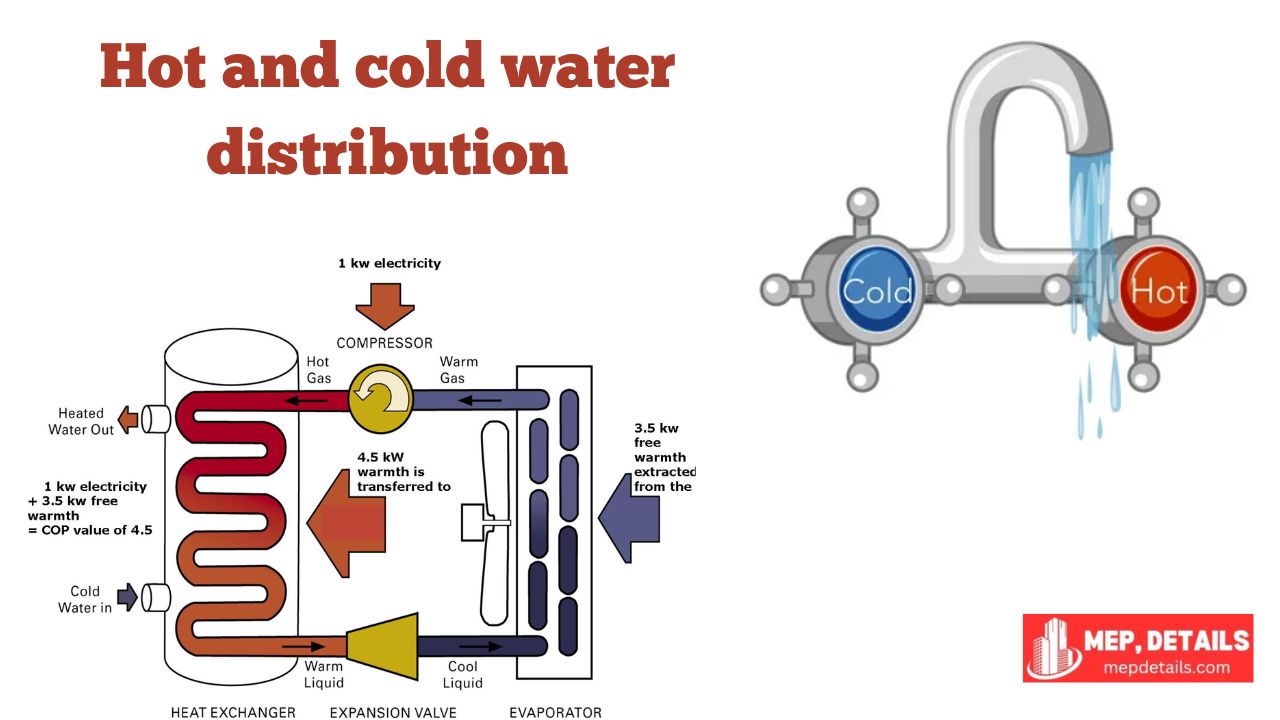Hot and cold water distribution systems bring warm and cold water to homes and buildings. These systems ensure comfort for daily tasks like bathing and cooking. Proper design prevents leaks, balances water flow, and saves energy for users.
Now, picture yourself putting your finger and getting either hot or cool water in the kitchen as soon as you turn the faucet on. Both hot and cold water systems make this possible, providing comfort to everyday life by simply twisting it.
Stay with us to learn how hot and cold water distribution works and why it matters. From smooth water flow to energy savings, we’ll guide you through the essentials, making it simple and useful for your everyday life.
The Basics of Hot and Cold Water Distribution

Hot and cold systems have become part and parcel of human life in today’s world. They also make possible the provision of water at taps, showers and other appliances. The systems are to provide a steady pressure and heat regime owing to the water conditioning systems installed. The water to be stored is heated through boilers, heaters or solar systems for water heating while the cold water is supplied from the main supply.
Such systems require pipes of material such as copper, PEX or PVC. Water which is used in pipes which distribute warm water is also typically surrounded with insulation in order to minimize the loss of heat.Cold water pipes remain uninsulated but are designed to resist freezing. The balance between the two ensures comfort and functionality.
Components of the System
There are following components of this system:
Water Heater: The key component for hot water supply, responsible for heating and storing water for use.
Cold Water Connection: Requires a direct link to the main supply for continuous access.
Valves:
- Check valves prevent backflow.
- Mixing valves blend hot and cold water for desired temperatures.
Pumps: Boost water pressure, especially in larger buildings or areas with low pressure.
System Efficiency: All components work together to ensure smooth and efficient water delivery.
Hot Water Distribution System

Hot water distribution networks circulate hot water for elements such as washing, preparing and ablution. This may be done by a boiler, a tankless water heater and even through solar systems. It is then transferred in insulated pipe work in order to ensure that temperature of the stream is well regulated.
Modern systems include recirculation pumps. These pumps ensure hot water is available instantly at taps. This reduces water wastage and improves convenience. The system is designed for energy efficiency and user comfort.
Cold Water Distribution System

Cold water distribution systems deliver water for drinking, cooking, and general use. This water comes directly from the main supply or a water storage tank. It will be interesting to note here that pipes for cold water are generally more robust in construction than their hot water counterparts.
This one relies on pressure from the mains in supplying water through the pipes. In areas with low pressure, pumps may be added to maintain flow. Proper design ensures there are no leaks or contamination in the supply.
Hot and Cold Water Mixing
Mixing hot and cold water happens in faucets, showers, and other fixtures. Mixing valves are used to control the water temperature. These valves blend hot and cold water to create the desired temperature for the user.
Thermostatic mixing valves are commonly used in modern systems. They ensure safety by preventing water from getting too hot. Mixing systems improve user comfort and make water usage more efficient.
Common Challenges in Distribution Systems
One common challenge is maintaining water pressure. Uneven pressure can lead to imbalances between hot and cold water. This affects the performance of fixtures and appliances.
Another issue is pipe corrosion.Deposition as a form of corrosion on metal pipes ultimately lowers the flow rate and degrades water quality. This can be avoided by routine checks and where possible, the use of materials that do not corrode easily. Additionally, scaling in hot water pipes due to hard water is a frequent problem.
Hot and Cold Water Pipe Layout
Pipe arrangement in a distribution system is very important. Hot and cold water pipes are usually arranged in the same horizontal line. This means that distribution to fixtures is even across the layout.
The hot water pipes are also well insulated with an aim of preventing heat losses. The pipes which convey cold water are avoided to have closeness with heat sources so as not to be warmed. Proper spacing between pipes prevents heat transfer and maintains efficiency.
Plumbing Materials Used
It also states that hot and cold water pipes are made of different materials. Copper is long lasting and non sticky to bacterial formation but costly. PEX is flexible, easy to install, and economically efficient when used widely in modern home plans.
PVC is lighter and cheaper but not to be used with hot water. The metallic housing is for a few high end systems and it is manufactured from stainless steel to prevent corroding. Decisions include material which depends on the budget, water temperature and necessary durability of the panel.
Energy Efficiency in Hot Water Distribution
Energy efficiency is a major focus in hot water systems. Heat insulating pipes minimize heat transfer and hence, heat losses in transportation of water. A tankless water heater requires sand and operates on demand thus consuming less energy than a storage tank.
Solar water heaters belong to green energy solutions and are cost saving. Recirculation systems do not waste water and take only a short time to provide hot water. These methods ensure hot water is provided efficiently while lowering energy consumption.
Safety Measures in Distribution Systems
Protection is important when using hot and cold water systems. Safety valves control and prevent high pressure on the pipe lines. Anti-scald devices help to avoid burning from hot water.
Cold water systems have backflow preventers that check water of any return into the water supply. Maintenance checks guarantee that the systems offer safety to the inhabitants.Modern systems also include thermostatic mixing valves for added temperature control.
Innovations in Water Distribution Systems
Advances in technology have improved hot and cold water distribution.Smart faucets make it easier for a user to regulate temperature and the rate of flow. Smart water heaters have capabilities to control heating of water and set schedules for such heating.
Leak detection sensors also fall under innovations. These sensors let people know when something is leaking and hence no water loss occurs as a result of burst pipes. With these ideas, water distribution systems are slowly being transformed to becoming smarter and more dependable.
Maintenance Tips for Longevity
There are some important steps which should be practiced to carry hot and cold water properly and for maintenance of these, regular maintenance of these pipes and chutes is very important. There is advice for checking pipe systems for leakage or indication of corrosion. Water heaters require optimization, specifically, what is commonly referred to as a flush.
Hose and hose assemblies should be inspected for conditions of serviceability. Hot water services should also have their pipes insulated, and any worn out insulation should be replaced. Following these steps ensures the system lasts longer and performs efficiently.
Environmental Impact of Water Distribution
Hot and cold water systems have an environmental impact. Heating water consumes energy, contributing to carbon emissions. Cold water systems may wastewater if leaks or inefficient fixtures are present.
This problem can be minimized by using energy-efficient heaters as well as the sealing of the leaks. Low-flow faucets and showerheads use less water as they flow without any difference to normal flow fixtures. It also enables drafting measures that are thrifty of resources and friendly to the natural setting.
The Importance of Proper Installation
Water heating and cooling system installations should be properly done. If done incorrectly, this results in leakage and pressure inconsistency or the equipment not operating properly. Professional plumbers make sure that the pipes are well fixed and the joints are well sold.
Inspections after installation verify the system meets safety and efficiency standards. Investing in quality installation ensures long-term reliability and fewer repairs.
Conclusion
A hot and cold water distribution service is almost the norm in native and contemporary dwelling and structures. These systems also make it possible for water to be supplied at the right temperature for washing, for instance, or showering, or for use in cooking. Conducted effectively these are technologically suitable systems that reduce leakage, are precise in their control of water pressures and efficient in their use of energy. When understood, these systems enable homeowners to have convenient access to water and also save on the amount of water, and energy that is used.
Many homeowners never appreciate the feeling of having a well installed hot and cold water system not only makes the life of every user more comfortable but also adds to the value of the property. Using quality components and service from time to time maintains the dependability of a product with a long duration. The new century brought innovation to the distribution systems that are becoming more personalized and tailored to meet individual requirements. That point is embracing these innovations to make life blend and be comfortable while at the same time reducing harm on our natural environment.
FAQs
What is the difference between hot and cold water supply systems?
Heated water supply delivers hot water for aspects such as washing hence known as hot water supply. The cold water supply provides unheated water for drinking or cleaning. Both systems use separate pipes; however, they often share a network.
What is hot water distribution?
Which direction is hot and cold water?
In most cases, the hot water control knob is on the left side and the cold one is on the right side of the control knob. This standard helps avoid confusion during use; therefore, it ensures clarity and consistency.
What is it called when hot and cold water meet?
It’s called mixing. Mixing happens in faucets or valves, blending hot and cold water to reach a desired temperature.
What is the main difference between hot water and cold water?
Hot water is heated and used for cleaning or bathing. Cold water is unheated and used for drinking or cooling. Temperature is their primary difference.
Also Read This : Pressure Reducing Valve: Features, Advantages, and Applications
